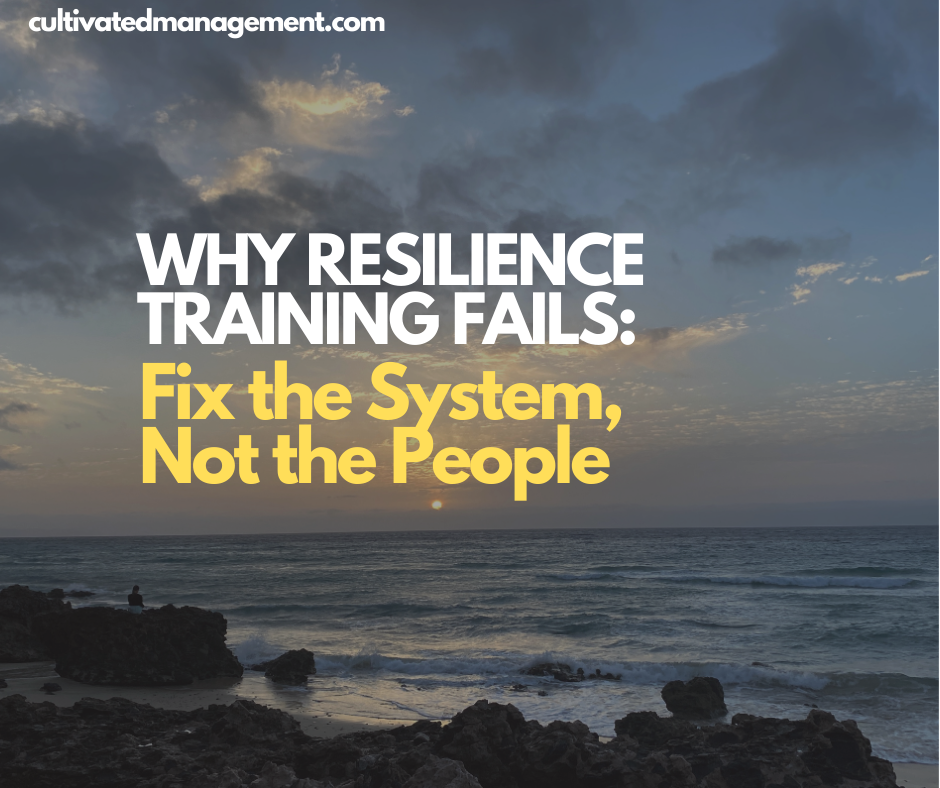
I once worked in a company with a serious wellbeing crisis.
- Sickness levels were at record highs.
- Burnout was spreading.
- Long-term sick leave was the worst I’d ever seen.
Despite endless initiatives — “Wellness Wednesdays,” yoga classes, fruit baskets, and helplines — the problem only got worse.
So, what did the exec team do? They retreated, discussed…and decided the problem wasn’t them or the business. It must be the employees. They just weren’t resilient enough.
Cue the new campaign: “Be more resilient.”
Employees got free books, courses, and tutorials on resilience. And yet, sickness rates continued to rise.
Why? Because resilience training doesn’t fix a broken system of work.
The Problem: Passing the Burden
Instead of owning the wellbeing crisis, leadership pushed the problem onto employees.
- “You’re not resilient enough.”
- “It’s HR’s fault.”
- “The team didn’t deliver.”
Passing the burden is one of the most damaging habits in any organisation. It shifts ownership to people who often have no control over the root causes.
In this case, the execs ignored the real data and focused on engagement surveys and eNPS scores — believing that high engagement automatically equals high wellbeing.
It doesn’t.
The Engagement Survey Trap
The company became obsessed with surveys. eNPS was treated as the most important metric — even above revenue and profit.
The result?
- Teams gamed the numbers.
- Poor performance was tolerated to “keep people happy.”
- Managers avoided tough conversations.
- Toxic behaviours were ignored.
- Engagement scores rose while the business declined.
Some of the most “engaged” teams delivered zero business value…and had the highest sick rates.
Why? Because people don’t just want perks and rank and pay. They want meaningful work, talented colleagues, and a system that helps them succeed.
This company over-indexed on Employee Engagement at the expense of actually creating meaningful, value driven work. And all hard conversations about performance couldn't be undertaken, in case it upset someone....and affected the engagement numbers.
In one team the leader offered to take everyone out for lunch if they scored highly on the engagement survey. Guess what happened?
In another team the leader threatened to give a poor performance review to anyone who lowered their engagement scored. Can you guess what happened?
The System Was Broken
Employees weren’t struggling because they lacked resilience. They were struggling because:
- Work was constantly blocked or delayed.
- Rules and policies made basic tasks impossible.
- Low performers went unchallenged.
- Managers didn’t deal with poor behaviours.
People were stuck in a system that made good work almost impossible. And when people can’t do their best work, wellbeing collapses.
I see people burning out from regular, non-taxing work days (9-5) because they are working on meaningless work.
The Leaders Who Got It Right
Not every manager fell for the survey trap. A few ignored the eNPS obsession and instead:
- Fixed systemic issues.
- Removed red tape.
- Communicated clearly.
- Dealt with poor behaviour.
- Clarified roles and expectations.
These teams had low sickness, high wellbeing, and ironically, high engagement too.
The lesson? Wellbeing improves when leaders fix the system AND care for their people.
What Leaders Should Do About Wellbeing
If you’re serious about improving wellbeing in your organisation, don’t just hand out yoga mats or resilience books. Start here:
- Own the problem. Don’t pass the burden to employees.
- Study the system. Follow the work — where does it get stuck or blocked?
- Ask frontline staff. They know exactly what’s broken.
- Deal with poor behaviours. Don’t let politics or toxic behaviour slide.
- Balance care with clarity. Support people while removing obstacles to meaningful work.
Final Thought
Yes, resilience has its place. But even the most resilient people will be ground down by a toxic or broken system of work.
Leaders and managers need to stop passing the burden, listen deeply, and focus on building systems where people can succeed.
When you combine genuine care for people with systemic improvement, you create a workplace where wellbeing, engagement, and business results can all thrive.
